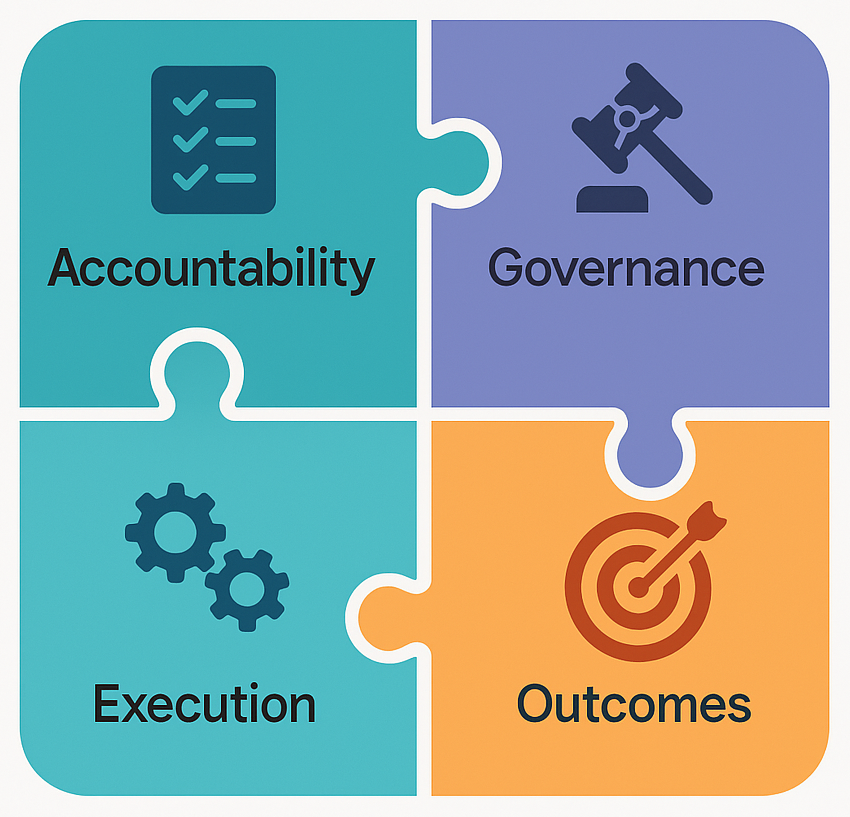Real Talk to Real Results: How Transformation Becomes a Habit

Somewhere along the way, “digital transformation” became a phrase that gets tossed around more than it gets lived out.
It shows up in the slide decks, board meetings, and marketing slogans. It promises efficiency, speed, innovation. But the truth is, transformation has never been about the technology.
It’s about tenacity.
It’s about whether the change you start has the discipline to survive once the headlines fade.
That’s been the heartbeat of Real Talk to Real Results.
Not theory. Not hype. Just the reality of what it takes to move from intention to impact...and stay there.
The Real Work Beneath the Buzzwords
If you’ve been part of a transformation, you know the pattern. The kickoff is electric. People nod in agreement. New acronyms appear overnight.
And for a little while, it feels like progress is being made.
But somewhere between enthusiasm and execution, things start to wobble.
The ownership drifts away. Priorities start to become hazy. The new flashy dashboards fill up, but no one looks at them anymore.
It’s not because people don’t care. It’s because transformation runs headfirst into the tension between aspiration and attention. Most companies can rally around vision statements. But few can stay consistent long enough to see those visions through.
That’s why the leadership matters more than the launch plans. Why governance matters more than any good intentions. And why clarity matters more than speed.
Because any transformation won't fall apart from lack of ideas.
It going to fall apart from lack of will to do the right things.
Sustainment is the Hardest Part
Leadership accountability has always been the foundation. When the leaders show up, transformation breathes. When they don’t, everything else will crumble.
But accountability isn’t about micromanaging. It’s about modeling the right behaviors. It’s leaders being visible when the work gets messy and when teams lose momentum, the decisions get hard, and ultimately, the progress slows to a crawl.
That visibility is what creates belief.
Belief grows when people see leaders practicing the behaviors they’re asking others to live by.
John Kotter’s research (2012) calls this visible sponsorship, the non-negotiable ingredient that keeps transformation alive. And it’s right. Because when accountability is visible, the culture follows.
Then there’s governance, the word everyone loves to hate.
In some organizations, governance is treated like red tape. But real governance is what turns chaos into confidence. It’s what prevents “who decides what” from becoming a weekly guessing game.
Hanisch and Lindeque’s (2023) work on digital governance reinforced this truth: clear decision rights aren’t bureaucracy; they’re oxygen. They let teams move fast without spinning out.
And good governance isn’t about control. It’s about alignment.
It says, “We all know who owns this, and we all know why it matters.”
That’s not slow, it's clarity. And clarity accelerates everything.
The Shift That Changes Everything
Somewhere in the middle of our series, the conversation changed.
Because once leadership and governance find their rhythm, the real question becomes: are we chasing output or outcomes?
It’s easy to mistake activity for achievement. We all do it.
The project finishes up, we launch a new tool, or a milestone gets checked off. And everyone exhales like we’ve crossed the finish line.
But in reality, that’s where the real work begins.
True transformation lives or dies in the space between delivery and adoption. Between features and outcomes.
That’s why the organizations that thrive aren’t the ones that implement tools the fastest.
They’re the ones that stay disciplined enough to measure whether those tools actually changed anything.
The Agile Business Consortium (2024) described it perfectly: outcomes are the heartbeat of modern delivery. They’re what separate motion from meaning.
When outcomes are clearly defined, the decisions become easier. Waste minimizes. Ownership expands.
But when they’re vague, everything becomes blurry.
And when everything blurs, people start making up their own definitions of success.
Transformation starts to feel like a treadmill on slow...a lot of movement, but no real progress.
Where Most Transformations Go Quiet
And then comes the part no one likes to talk about: execution.
Execution is where the energy drains and where initiative fatigue sets in.
It’s where leaders who were once vocal fade into the background, assuming the system will run itself.
But the systems don’t sustain themselves, the people do.
Research by Oehmen and O’Connor (2022) found that most digital initiatives don’t fail because of flawed design. They fail in execution, when follow-through breaks down and learning stops. Execution that sticks requires endurance. It requires feedback loops, consistency, and the humility to revisit what’s not working.
It isn't glamorous. It doesn’t trend on LinkedIn.
But its the single biggest differentiator between companies that change and companies that pretend to.
Because transformation doesn’t collapse in the strategy, it collapses in repetition.
The real question isn’t “Can we start strong?” It’s “Can we stay strong when nobody’s watching?”
When Transformation Becomes a Habit
When you strip it all back, everything we’ve talked about comes down to following:
- Leadership that keeps showing up.
- Governance that keeps decisions clear.
- Outcomes that keeps focus tight.
- Execution that keeps progress alive.
Each of these reinforces the other.

That’s the loop. That’s the flywheel.
And when it’s consistent, transformation stops being a “program.”
It becomes second nature: something the organization is, not something it does.
MIT Sloan (2023) calls this the “cultural layer” of transformation...when change stops being a talking point and starts being muscle memory.
You don’t need to remind people what transformation means anymore. They’re already living it.
That’s when you know it’s real.
The Real Lesson
Across every story, every case study, every framework; the pattern repeats: transformation is a test of leadership stamina.
It’s not just about making decisions; it’s about making the right decisions, again and again, until they stop feeling new.
It’s about leaders having the courage to say, “We’re not ready for that next tool until we fix the foundation.”
It’s about governance that protects alignment instead of policing it.
It’s about defining success in business terms, not just slide decks.
And it’s about building execution disciplines that keep going long after the launch celebrations end.
Because what most organizations call transformation is really just implementation.
And what most call success is really just survival.
Real results come from the ones who can sustain the boring parts: the reviews, the retros, the reinforcement. That is where consistency is built.
That’s where trust grows.
That’s where culture changes.
That’s where the real work lives.
Looking Ahead: The Next Chapter
As this series closes, our work doesn't stop. It grows more and more important.
Because every one of these themes: leadership, governance, outcomes, execution...rests on one essential truth: you can’t transform what you can’t trust.
And that trust starts with the data.
Our next series will go into the heart of how data fuels every corner of transformation. We’ll explore how trust, lineage, and ownership shape decision-making, how data quality becomes cultural currency, and how governance and insight become the bridge between ambition and action.
If Real Talk to Real Results was about how organizations transform, the next series will be about how they see.
Because data isn’t just a byproduct of transformation.
It’s the foundation that makes it possible.
The Real Result TL;DR
Transformation isn’t magic. It’s not speed. It’s not hype.
It’s leadership that stays visible.
Governance that builds trust.
Outcomes that prove value.
Execution that doesn’t fade.
It’s the courage to keep showing up when it would be easier to move on.
That’s how transformation becomes a habit.
That’s how results become real.
Let’s get real.
Real talk. Real strategy. Real results in digital transformation.
References
Agile Business Consortium. (2024, October 17). The importance of focusing on outcomes in project management.https://www.agilebusiness.org/resource/blog-the-importance-of-focusing-on-outcomes-in-project-management.html
Gartner. (2021). Cultural readiness: A critical success factor for digital transformation. Gartner Research.
Hanisch, C., Lindeque, J., & Sütterlin, S. (2023). Digital governance: A conceptual framework. Journal of Business Research, 160, 113765. https://doi.org/10.1016/j.jbusres.2023.113765
Kotter, J. P. (2012). Leading change. Harvard Business Review Press.
MIT Sloan Management Review. (2023). Leadership’s digital transformation: Leading purposefully in an era of context collapse. https://sloanreview.mit.edu/projects/leaderships-digital-transformation
Oehmen, J., & O’Connor, R. V. (2022). The execution gap in digital transformation. International Journal of Project Management, 40(6), 567–579. https://doi.org/10.1016/j.ijproman.2022.05.004